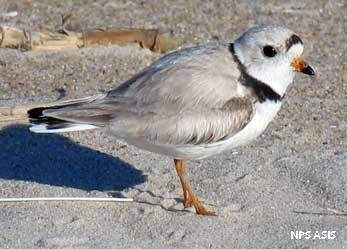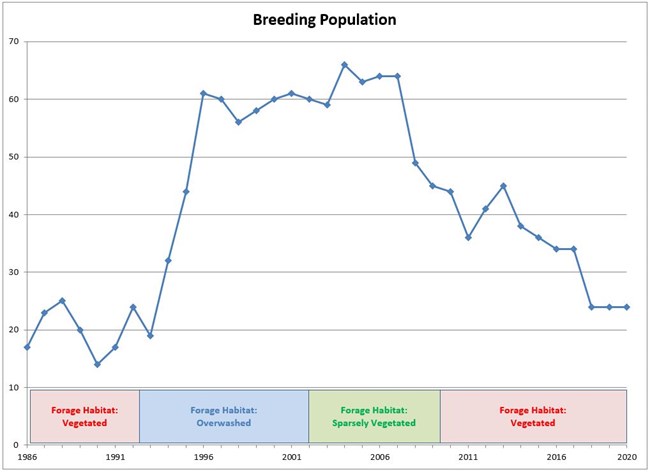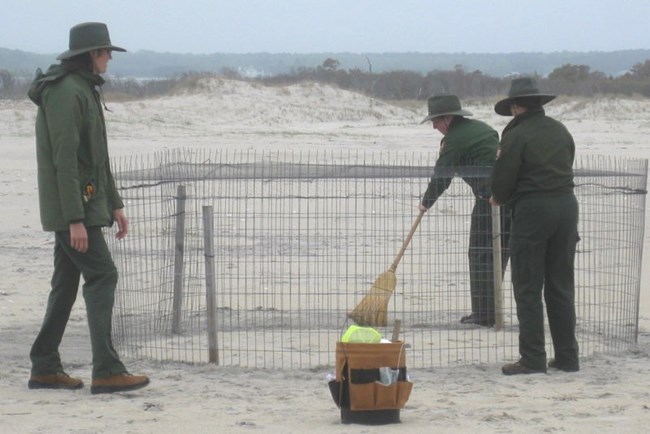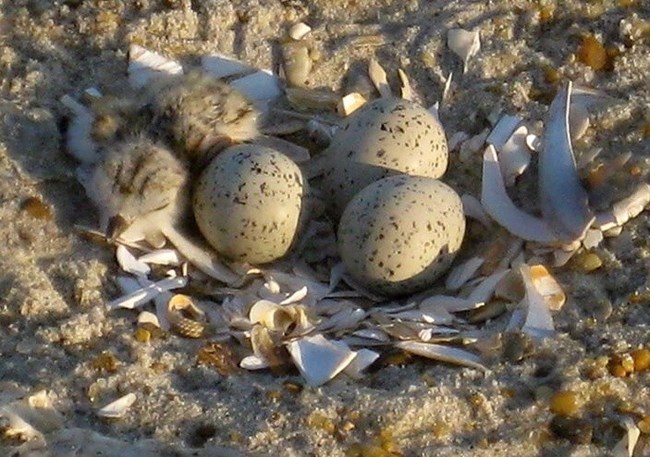
NPS photo BackgroundThe piping plover (Charadrius melodus) is a robin-sized, migratory shore bird. It is 18 cm (7.25 in) in length and has a wing span of approximately 38 cm (15 in). Assateague Island plovers prefer to nest on open beaches, between sparsely vegetated dunes with easy access to moist, open areas for foraging. Predominantly insectivores, plovers will also consume soft bodied invertebrates.The Atlantic coast population of the piping plover was listed as a threatened species under the U.S. Endangered Species Act in 1986. Plovers, already sparsely distributed along the Atlantic seaboard, are competing with insistent human encroachment and disturbances, as well as natural habitat changes. Understanding the relationship between the piping plover and its habitat is critical to the successful management of the species. 
NPS Status and TrendsNationwide, piping plover populations have historically fluctuated. In the 1900s, the unregulated hunting of the birds placed them near extinction. By the mid-1920s the population began to increase in part due to protective legislation, but by the mid-1940s rapidly declining plover numbers were attributed to increased use of beaches for recreational purposes (Tate 1981).In addition to being impacted by human disturbance, plover populations on Assateague are directly affected by natural changes in their environment. In view of the fact that plovers exhibit better than average breeding success in areas with minimal vegetation and easy access to their preferred foraging sites, plovers rely heavily on winter storms that produce areas of overwash. Overwash occurs when ocean water rushes across the island during periods of high water and wind. As sand is deposited on the island interior, it covers up large areas of vegetation. This activity creates essential moist, undisturbed foraging habitat for plover chicks and adults. Over time, without the occurrence of significant storms, vegetation will encroach on the open overwash fan. Gradually vegetation will fill in the overwash and obstruct the movement of plovers, limiting their ability to forage for food. Research continues to highlight the value of overwash areas to the survival of plovers (Loegering 1992); however storms that cause overwash are not an event that managers of the national seashore can control. Even though overwash may be perceived as destructive, it is imperative that natural processes be allowed to take place. What appears to be destructive is actually essential to achieve a sustainable piping plover population. 
NPS Photo Management and MonitoringBased on data trends, it is eveident that continuous management of this species is highly warrented. Seasonal monitoring of the piping plovers on Asaateague Island takes place from April until September each year. Monitoring involves the documentation of the number of breeding pairs of plovers, the number of chicks that hatch and the number of chicks that fledge. It also involves the documentation of nesting site characteristics, brood territory, surrounding area vegetation density and topography.Plovers are sensitive birds and can be easily displaced from their desired nesting and foraging habitats by wildlife and human disturbances. To help curtail these disturbances, measures are taken to control wildlife interference during the breeding and nesting season. As plover nests are identified, circular wire exclosures are erected around the perimeter of the nesting site. The wire mesh is small enough to exclude mammalian predators but allows the plover access to the nest. The wire is buried below the surface, with the tined end facing upward to prevent predators from perching or climbing into the exclosure. A fabric mesh is stretched over the top to deter avain predators from entering the exclosure from above. This design has evolved over many years based on chick hatching data and nest predation observations. 
NPS Photo During the first signs of courtship initiation, signs are placed approximately 200 meters (218 yards) away from any locations used for nesting or foraging. This "disturbance buffer" is established to prevent pedestrian foot and vehicular traffic from disturbing plovers by forcing them away from their eggs or chicks for prolonged periods of time. With parent birds driven from the nest, chicks are exposed to predators and eggs to extreme temperatures. Because plover habitat use patterns have been well established through years of monitoring, seashore managers have a general idea about where on Assateague they may need to plan for temporary closures. These areas are typically closed when the plovers begin to court and are reopened when all of the chicks in the restricted area are able to fly. Data, as well as behavioral observations, allow national seashore managers to better understand the plover. As such, they are better prepared to protect and manage the habitat that it relies on for survival. ReferencesLoegering, J. 1992 Piping Plover Biology, Foraging Ecology and Behavior on Assateague Island National Seashore, Maryland. Masters Thesis. Virginia Polytechnic Institute and State University, Blacksburg, VA. 248 pp.Tate, J. 1981 The blue list for 1981. Am. Birds 35:3-10 US Fish and Wildlife. (2012). Species Profile for Piping Plover. Retrieved from http://ecos.fws.gov/speciesProfile/profile/speciesProfile.action?spcode=B079 |
Last updated: January 16, 2021
